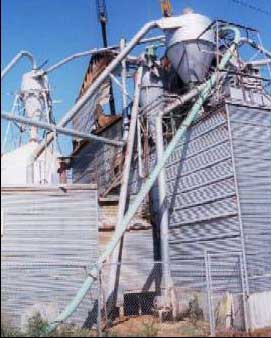|
Dust Explosions
A dust explosion is very similar to a gas or vapour cloud
explosion, i.e. when a volume of a flammable mixture is ignited,
resulting in a rapid pressure increase and fire moving through
the cloud. A dust explosion occurs when a combustible material
is dispersed in the air forming a flammable cloud and a flame
propagates through it. This of course also depends on the
supply of oxygen to the fire, and the concentration of the
fuel, if either of these are in too high or low then the explosion
will not occur.dust explosions are common and costly in a
wide array of industries such as petrochemical, food, paper
and pharmaceutical. It is imperative that practical and theoretical
knowledge of the origin, development, prevention and mitigation
of dust explosions is imparted to the responsible safety manager.
WHAT IS AN EXPLOSION
In an explosion a large quantity of energy is released
in a short time, causing a fast pressure raise. A bursting
pressure vessel is an example of a physical explosion, because
no chemical reaction takes place. A dust explosion is a
chemical explosion: the suspended dust particles react violently
with the oxygen in the atmosphere, which causes the mixture
to heat up swiftly. In a closed vessel the expanding atmosphere
creates overpressure |
 |
|
The Prevalence of Dust
Many materials, ranging from baking flour to metal dusts, can
fuel dust explosions when present in a finely divided state. Some
materials are intentionally used in a powder or dust form in manufacturing
while other dusts are created as unintentional byproducts. Examples
of materials that have historically caused dust explosions include:
Cosmetics
Coal
Dyes
Grain and other dry foods
Metal
Pharmaceuticals
Plastic and rubber
Printer toner
Soaps
Textiles
Wood and paper |
|
In the year 2003 alone, there were at least 14 deaths and 81 injuries
related to dust explosions. In response to these and several other
recent dust explosions, the U.S. Chemical Safety and Hazard Investigation
Board (CSB) recommended that government agencies, insurers, and
others provide their inspectors with increased training on recognition
and prevention of dust explosion hazards. This and the publicity
from recent catastrophic dust explosions will likely increase
enforcement of standards for the prevention of dust explosions
by inspectors. When inspectors identify dust explosion hazards
or issue citations to facilities, Exponent assists clients in
quantifying dust explosion hazards and evaluating the validity
of citations issued by government inspectors. We also assist clients
in identifying cost-effective methods for abating dust explosion
hazards.
Addressing the Issue
Exponent designs testing programs to quantify the dust explosion
hazards of materials in client’s facilities using both standard
ASTM testing methods and methods developed by Exponent. Based
on the measured hazard level, when appropriate, we assist the
client in identifying mitigation techniques and applicable standards
and regulations for the prevention of dust explosions including
standards developed by the NFPA. Methods to prevent or mitigate
explosions include:
Preventing releases of fugitive dust into facilities
Housekeeping to remove accumulations of dust
Eliminating ignition sources
Inerting explosive atmospheres
Fire and explosion suppression systems
Segregating areas with dust explosion hazards
Properties that affect the Dust Explosion Hazard
Preventing Dust Explosions
Mitigation Methods
Dust Explosion Cases
|

